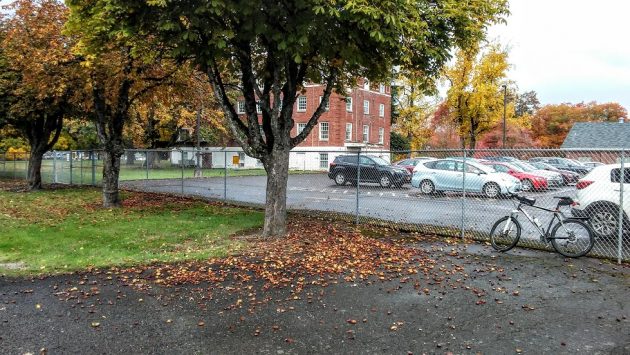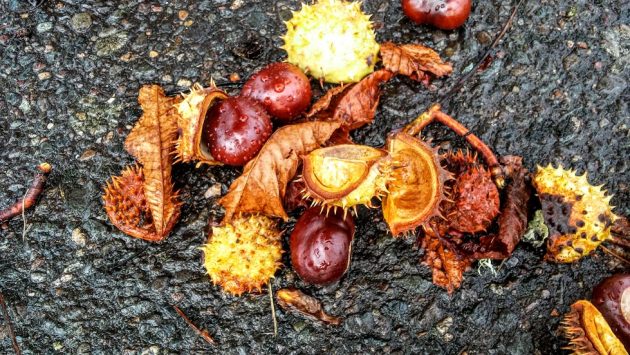
Now if only you could do something with all those horse chestnuts, or conkers, lying on the ground. But even if you could roast or cook and eat them, you had better not, because they contain a toxin or two.
That, anyway, is what I learned online after I looked for more information on horse chestnuts, those ubiquitous products of autumn littering the pavement up and down many Albany streets.
These I came across on Friday on Broadway Street south of Queen. Wondering about the difference between these chestnuts and the edible kinds, I enlisted the help of Google. And if you’re interested, I sugggest you do the same.
You’ll learn that the several varieties of edible chestnuts can be distinguished by the little tassles or points on each nut. Horse chestnuts, or conkers, don’t have that.
Can you do anything with conkers? Well, you can try to plant a few and see if anything comes up. Or you can try your hand at the game of conkers, which supposedly is popular among children in Britain. At least those few who don’t prefer the diversions on their phones, presumably.
YouTube tells you how to play the game, which involves putting a chestnut on the end of a shoe string and then trying to hit another that is similarly strung up. YouTube also has a report on the world championship of conkers. Believe it or not.
As for the chemicals in Aesculus hippocastanum, they apparently have some medicinal uses. But they sicken animals that eat the leaves or nuts. Unfortunately that does not include deer, who like nothing better than to nibble the new growth on the horse chestnut starts that managed so far to survive in our yard. (hh)

Plenty of conkers under this tree near the Albany National Energy Technology Lab.

And a closer look.

CONKERS – your article brought back many happy memories of my childhood in England. We found them along many streets in our neighborhood. A large and shiny conker was a great prize – to be treasured – along with string snatched from our kitchen. Of course, this was during WWII when few, if any, new toys were bought. My Mother sewed a small bag for me to keep my conkers safe. We played on and across the streets – no cars around, no gas (petrol). After school the kids were busy sorting thru piles of these nuts – never the huge pile you found though. It was wartime, food shortages, bombing at night, but we were kids and could always find some fun time and we always played outside. Thanks again HH.
Some people call them buckeyes. I ask if they’re from Ohio. They were.
Conkers the Game.
When I went to school in England, ’60s, the thing was to save a conker or two from the previous year, and store them over the winter. They were then dried and hardened, a distinct advantage over the fresh conkers. After drilling a hole in your prized nut and installing an 18″ to 20″ shoestring with a large knot at the end, you could then either issue a challenge, or entertain one. But before agreeing, you would want to know the value of the opposing conker. For each victory any particular conker attained not only a point for the win, but also acquired the accumulated value of all the points the vanquished conker had earned. Thus a conker of high value, say 200+, would be a worthy opponent for your own dried, hardened and battle-scarred warrior.
The challenger would then hold out his conker at arms length by the string, suspended and still, while the opponent stretched his string between the thumb of one hand, holding the conker between two fingers of the other. He would then let fly with an exaggerated two-arm swing, releasing the conker at the apex to accelerate down and smash into the hapless opponent hanging impotently to receive the blow. Corinthian honor prohibited any defensive movement. Great skill was required to aim and deliver the fatal strike, with the aim of cracking the receiving conker so that it was no longer attached to the string. If both conkers remained intact, or at least viable and still strung, the combatants then exchanged roles. The contest continued then until one or the other was destroyed, the points of the loser transferring to the winner, plus one.
Thanks very much for this description. Just one question. How could you be sure that a veteran conker’s points total was what its owner claimed it to be? Relying again on Corinthian honor?